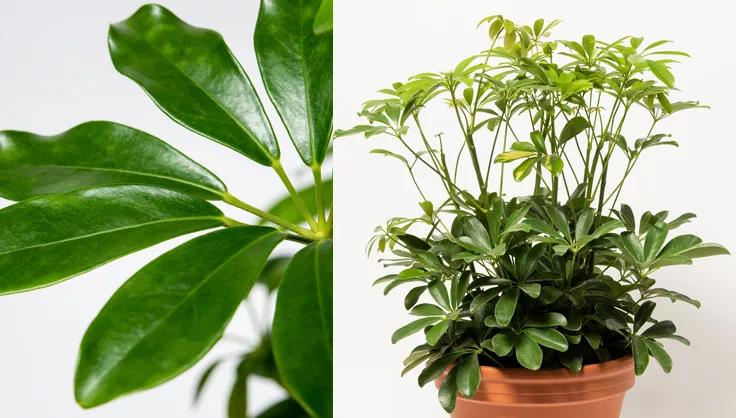How to Grow & Care For an Umbrella Tree

Members of the Araliaceae family, umbrella trees are native to New Guinea, Australia, and parts of Taiwan. These trees are characterized by their glossy, palmate leaves that radiate from a central point, resembling an umbrella. In their native habitat, umbrella trees can be up to 50 feet in height. Luckily, those grown as houseplants are typically no taller than 3-6 feet tall.
Types of Umbrella Tree to Try
Umbrella trees are generally either one of two species: Schefflera actinophylla or Schefflera arboricola. They are very similar in appearance, with the exception of the leaf length; S. actinophylla generally has leaves that are at least 5 inches long.
Umbrella trees are most commonly found with solid emerald green leaves, however striking, variegated varieties like 'Gold Capella' (creamy yellow and green leaves) or 'Janine' (marbled white and green) are excellent choices.
Best Conditions for Umbrella Trees
Light
Umbrella Trees thrive in bright, indirect light. They can tolerate some direct morning sun but should be shielded from harsh afternoon rays, which can scorch their leaves. A spot near an east-facing window is ideal.
Soil
These trees prefer a well-draining, loamy potting mix. A standard indoor potting soil mixed with some perlite or orchid bark works well, ensuring proper drainage and aeration.
Humidity
Although the umbrella tree can endure standard household humidity levels, it prefers higher humidity. In environments with dry air, particularly during winter when central heating is active, consider using a humidifier or placing the plant on a tray filled with pebbles and water.
The umbrella tree flourishes in typical room temperatures ranging between 60°F to 75°F . While it can withstand slightly cooler conditions, it is advisable to avoid exposing it to temperatures below 55°F (13°C) or drafts, as this may lead to leaf drop or slow growth.
How to Care For Umbrella Trees
Watering
Water when the top inch of soil becomes dry. Umbrella Trees prefer consistent moisture but don’t like to sit in water. Ensure your pot has good drainage to avoid root rot.
Fertilizing
During their growing season (spring and summer), feed your Umbrella Tree with a balanced, water-soluble fertilizer every 2-4 weeks. In winter, reduce feeding as the plant's growth slows down.
Pruning
Pruning is necessary to maintain shape and encourage fuller growth. Trim back any leggy stems, and don’t be afraid to cut back aggressively if needed – these trees are quite resilient!
Repotting
Repot your Umbrella Tree every 2-3 years or when it becomes root-bound. Spring is the best time for repotting, giving the plant time to establish in its new pot before winter.
Propagation
Umbrella Trees can be easily propagated by cuttings. Take a stem cutting with at least two leaf nodes, dip it in rooting hormone, and plant it in moist soil. With patience and proper care, it will root and grow into a new plant.
Common Problems with Umbrella Trees
Pests and Diseases
Watch out for pests like spider mites, aphids, and mealybugs. Regularly inspect your plant and treat infestations promptly with insecticidal soap or neem oil. Overwatering can lead to root rot, so ensure your potting mix is well-draining.
Toxicity
Important note: Umbrella Trees are toxic to pets and humans if ingested. Keep them out of reach of curious pets and children.
Umbrella Tree FAQs
Q: Why are the leaves of my Umbrella Tree dropping?
A: Leaf drop can be caused by a drastic change in lighting or sudden exposure to cold temperatures. Ensure consistent watering and light, and keep your umbrella tree away from drafty doors or windows.
Q: Can I grow an Umbrella Tree outdoors?
A: Yes, in warmer climates (USDA zones 10-12), umbrella trees can be grown outdoors. Use them as a focal plant, as a living privacy screen, or group them together with other large statement plants, like Monstera. They make excellent patio plants but should be brought indoors during colder months in cooler climates — they don't do well in temperatures below 55 degrees F.
Q: How can I make my Umbrella Tree more bushy?
A: Regular pruning encourages fuller growth. Trim the tips of the branches, especially during the growing season, to promote bushier growth.
With their unique canopy-like foliage, umbrella trees make a stunning addition to any indoor garden or outdoor patio.
Print this Article:
Get the Dirt
Stay up to date on new articles and advice. Please fill out the information below.
